
The bombing of Dresden was a joint British and American aerial bombing attack on the city of Dresden, the capital of the German state of Saxony, during World War II. In four raids between 13 and 15 February 1945, 772 heavy bombers of the Royal Air Force (RAF) and 527 of the United States Army Air Forces (USAAF) dropped more than 3,900 tons of high-explosive bombs and incendiary devices on the city. The bombing and the resulting firestorm destroyed more than 1,600 acres (6.5 km2) of the city centre. Up to 25,000 people were killed. Three more USAAF air raids followed, two occurring on 2 March aimed at the city's railway marshalling yard and one smaller raid on 17 April aimed at industrial areas.

Firebombing is a bombing technique designed to damage a target, generally an urban area, through the use of fire, caused by incendiary devices, rather than from the blast effect of large bombs. In popular usage, any act in which an incendiary device is used to initiate a fire is often described as a "firebombing".
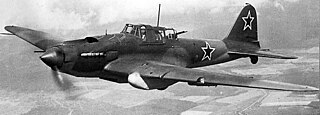
The Ilyushin Il-2 is a ground-attack plane that was produced by the Soviet Union in large numbers during the Second World War. The word shturmovík, the generic Russian term for a ground-attack aircraft, became a synecdoche for the Il-2 in English sources, where it is commonly rendered Shturmovik, Stormovik and Sturmovik.

A strategic bomber is a medium- to long-range penetration bomber aircraft designed to drop large amounts of air-to-ground weaponry onto a distant target for the purposes of debilitating the enemy's capacity to wage war. Unlike tactical bombers, penetrators, fighter-bombers, and attack aircraft, which are used in air interdiction operations to attack enemy combatants and military equipment, strategic bombers are designed to fly into enemy territory to destroy strategic targets. In addition to strategic bombing, strategic bombers can be used for tactical missions. There are currently only three countries that operate strategic bombers: the United States, Russia and China.
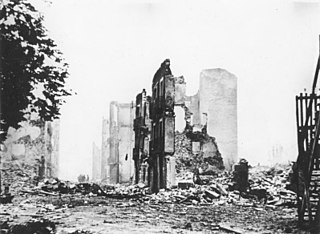
The aerial bombing of cities is an optional element of strategic bombing, which became widespread in warfare during World War I. The bombing of cities grew to a vast scale in World War II and is still practiced today. The development of aerial bombardment marked an increased capacity of armed forces to deliver ordnance from the air against combatants, military bases, and factories, with a greatly reduced risk to its ground forces. The killing of civilians and non-combatants in bombed cities has variously been a deliberate goal of strategic bombing, or unavoidable collateral damage resulting from intent and technology. A number of multilateral efforts have been made to restrict the use of aerial bombardment so as to protect non-combatants and other civilians.
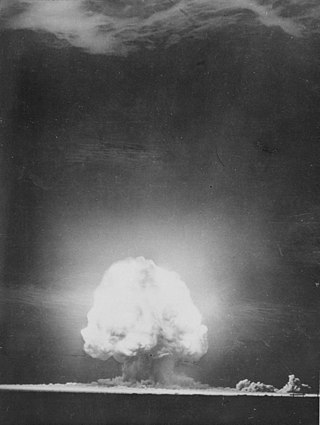
Technology played a significant role in World War II. Some of the technologies used during the war were developed during the interwar years of the 1920s and 1930s, much was developed in response to needs and lessons learned during the war, while others were beginning to be developed as the war ended. Many wars have had major effects on the technologies that we use in our daily lives, but World War II had the greatest effect on the technology and devices that are used today. Technology also played a greater role in the conduct of World War II than in any other war in history, and had a critical role in its outcome.

Operation Bagration was the codename for the 1944 Soviet Byelorussian strategic offensive operation, a military campaign fought between 22 June and 19 August 1944 in Soviet Byelorussia in the Eastern Front of World War II, just over two weeks after the start of Operation Overlord in the west, causing Nazi Germany to have to fight on two major fronts at the same time. The Soviet Union destroyed 28 of 34 divisions of Army Group Centre and completely shattered the German front line. It was the biggest defeat in German military history, with around 450,000 German casualties, while 300,000 other German soldiers were cut off in the Courland Pocket.
This is a list of aviation-related events from 1945:

World War II (1939–1945) involved sustained strategic bombing of railways, harbours, cities, workers' and civilian housing, and industrial districts in enemy territory. Strategic bombing as a military strategy is distinct both from close air support of ground forces and from tactical air power. During World War II, many military strategists of air power believed that air forces could win major victories by attacking industrial and political infrastructure, rather than purely military targets. Strategic bombing often involved bombing areas inhabited by civilians, and some campaigns were deliberately designed to target civilian populations in order to terrorize them and disrupt their usual activities. International law at the outset of World War II did not specifically forbid the aerial bombardment of cities – despite the prior occurrence of such bombing during World War I (1914–1918), the Spanish Civil War (1936–1939), and the Second Sino-Japanese War (1937–1945).

The bombing of Warsaw in World War II started with the aerial bombing campaign of Warsaw by the German Luftwaffe during the siege of Warsaw in the invasion of Poland in 1939. It also included German bombing raids during the Warsaw Uprising in 1944. During the course of the war, approximately 85% of the city was destroyed due to German mass bombings, heavy artillery fire, and a planned demolition campaign.
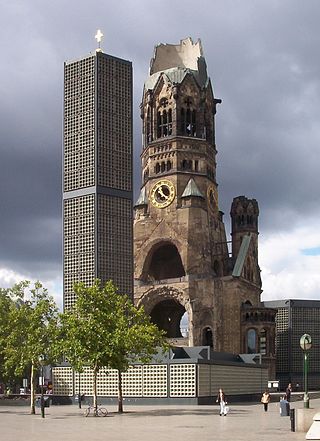
Berlin, the capital of Nazi Germany, was subject to 363 air raids during the Second World War. It was bombed by the RAF Bomber Command between 1940 and 1945, the United States Army Air Forces' Eighth Air Force between 1943 and 1945, and the French Air Force in 1940 and between 1944 and 1945 as part of the Allied campaign of strategic bombing of Germany. It was also attacked by aircraft of the Red Air Force in 1941 and particularly in 1945, as Soviet forces closed on the city. British bombers dropped 45,517 tons of bombs, while American aircraft dropped 22,090.3 tons. As the bombings continued, more and more people fled the city. By May 1945, 1.7 million people had fled.

"Night Witches" was a World War II German nickname for the all-female military aviators of the 588th Night Bomber Regiment, known later as the 46th "Taman" Guards Night Bomber Aviation Regiment, of the Soviet Air Forces. Though women were officially barred from combat at the time, Major Marina Raskova used her position and personal contacts with the Soviet leader Joseph Stalin to obtain permission to form female combat units. "Combat facilitated and ushered in a reluctant acceptance of women in military, based more upon practicality and necessity than for equality". On October 8, 1941, an order was issued to deploy three women's air-force units, including the 588th Regiment. The regiment, formed by Raskova and led by Major Yevdokiya Bershanskaya, was composed primarily of female volunteers in their late teens and early twenties.
During the Second World War, the city of Wuppertal suffered numerous Allied air raids, primarily nighttime attacks from the Royal Air Force's Bomber Command during its Battle of the Ruhr bomber offensive. The largest raids were on the night of 29-30 May 1943, heavy enough to cause a firestorm, and on 24-25 June. The wartime-era German Feuerwehr fire brigades were ill-equipped to fight the fires. The RAF's airstrikes destroyed areas of Wuppertal's north-eastern Barmen, central Elberfeld and south-eastern Ronsdorf communities, mainly through incendiary area bombing, resulting in destructive firestorms. Other Allied aircraft also carried out numerous smaller air raids on Wuppertal. Overall, more than 6,500 people lost their lives during World War II in Wuppertal from such raids; 38 percent of the built-up urban area was destroyed.

Stalingrad, a Soviet city and industrial centre on the river Volga, was bombed heavily by the Luftwaffe during the Battle of Stalingrad in World War II. German land forces comprising the 6th Army had advanced to the suburbs of Stalingrad by August 1942. The city was firebombed with 1,000 tons of high explosives and incendiaries in 1,600 sorties on 23 August. The aerial assault on Stalingrad was the most concentrated on the Ostfront according to Beevor. The destruction was monumental and complete, turning Stalingrad into a sea of fire and killing thousands of civilians and soldiers. At least 90% of the housing stock was obliterated during the first week of the bombing, with estimations of some 40,000 killed, possibly as many as 70,000 killed, though these may be exaggerations. Further fire-attacks were mounted against the ruined city for the next two days, enveloping it in dense volcano-like black smoke clouds that stretched 3.5 kilometers into the sky.

The bombing of Königsberg was a series of attacks made on the city of Königsberg in East Prussia during World War II. The Soviet Air Force had made several raids on the city since 1941. Extensive attacks carried out by RAF Bomber Command destroyed most of the city's historic quarters in the summer of 1944. Königsberg was also heavily bombed during the Battle of Königsberg, in the final weeks of the war.
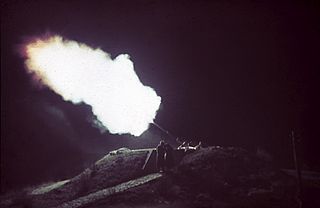
Helsinki, the capital of Finland, was bombed repeatedly during World War II. Between 1939 and 1944, Finland was subjected to a number of bombing campaigns by the Soviet Union. The largest were three raids in February 1944, which have been called The Great Raids Against Helsinki.

During World War II, the Estonian capital Tallinn suffered from many instances of aerial bombing by the Soviet air force and the German Luftwaffe. The first bombings by Luftwaffe occurred during the Summer War of 1941 as part of Operation Barbarossa. A number of Soviet bombing missions to then German-occupied Tallinn followed in 1942–1944.

The Hull Blitz was the bombing campaign that targeted the English port city of Kingston upon Hull by the German Luftwaffe during the Second World War.

Air warfare was a major component in all theaters of World War II and, together with anti-aircraft warfare, consumed a large fraction of the industrial output of the major powers. Germany and Japan depended on air forces that were closely integrated with land and naval forces; the Axis powers downplayed the advantage of fleets of strategic bombers and were late in appreciating the need to defend against Allied strategic bombing. By contrast, Britain and the United States took an approach that greatly emphasized strategic bombing and tactical control of the battlefield by air as well as adequate air defenses. Both Britain and the U.S. built substantially larger strategic forces of large, long-range bombers. Simultaneously, they built tactical air forces that could win air superiority over the battlefields, thereby giving vital assistance to ground troops. The U.S. Navy and Royal Navy also built a powerful naval-air component based on aircraft carriers, as did the Imperial Japanese Navy; these played the central role in the war at sea.

The bombing of Gorky by the German Luftwaffe was the most destructive attack on Soviet war production on the Eastern Front in World War II. It lasted intermittently from October 1941 - June 1943, with 43 raids carried out.


















